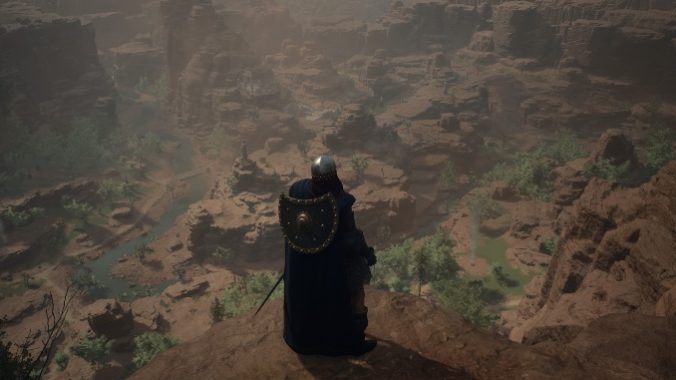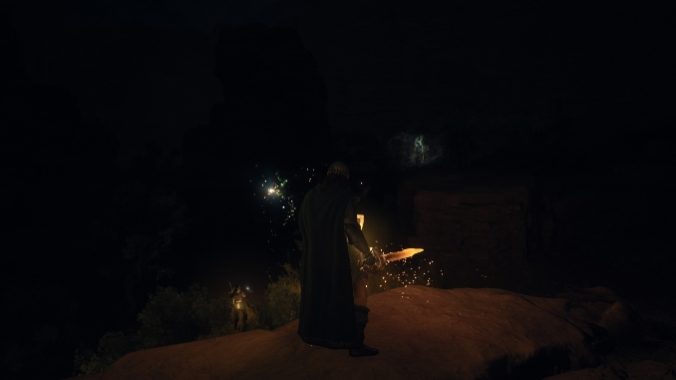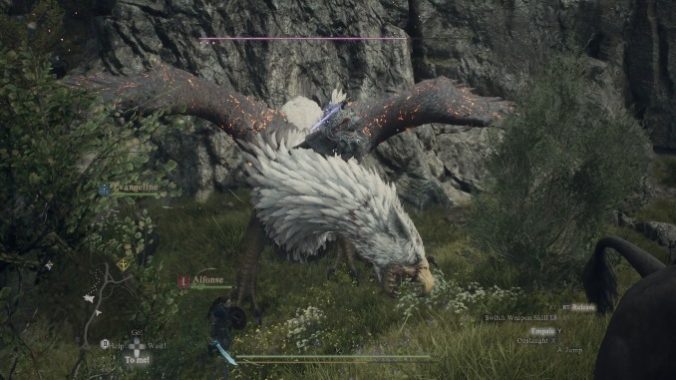In Dragon’s Dogma 2, You’re a Stumbling Meat Puppet in a World That Hates You (And That’s a Good Thing)

Dragon’s Dogma 2 begins with a coronation. You are the Arisen, the chosen enemy of the Dragon who, by virtue of having their heart scooped out by this beast, claims the right to the throne of Vermund (this doesn’t sound like the best system of governance to me, but what can you do). However, as adoring subjects serenade this ascension, something unexpected happens. A voice rings out. You collapse.
The camera cuts away to a gaol in a distant land, perhaps in the past. There’s a struggle, and the Arisen escapes into the wider world, setting out on a journey to claim their “rightful” spot at the top of Vermund, a quest aided by numerous loyal underlings. They’ll charge into battle for you, plan political machinations in your stead, and generally fall over themselves to fawn over your divine presence. In-universe, many of them are literally referred to as Pawns, undying beings whose sole purpose in life is to serve the Arisen. After all you’re the Sovran, their promised leader reborn.
However, although Dragon’s Dogma 2 casts the player as a fated king who commands a legion of peons, the definition of a power fantasy, ironically, almost every other layer of this experience reinforces an absence of control. You may be destined for the highest station in all the land, but the wilds of Vermund and Battahl truly do not give a shit. This space is vast, dense, and full of things that want to kill you.
Here, many of the trappings of modern open world games are intentionally thrown in the dumpster. While you can technically fast travel by using an item called a ferrystone, they are fairly scarce and expensive (at least in the early game), meaning spending one is always a genuine choice. They can’t teleport you just anywhere, and you can only warp to magical obelisks called portcrystals, which are similarly uncommon. The other main way to get around “quickly” is via Ox Cart, but these are also restrictive, as they only travel between major cities and can come under attack. Oh, and as far as I can tell, horses don’t exist in this setting, meaning most travel happens on foot.
Because of these limitations on moving through the world, you’re forced to fully engage with the contours of this sizeable backdrop, battling goblins, harpies, and eventually far more intimidating creatures as you cut a swathe to your destination. Due to the scope of battles and the lack of a universal dodge, even the most skilled warrior will take dings and scrapes along the way. Sure, there are plenty of healing tools at your disposal: you can carry medicines in your pack and assuming you have a Pawn in your party dedicated to healing (which you probably should), they’ll do their best to keep your HP topped off. But every time you get hit, you lose a bit of your max health that can’t be healed in the field, the wear and tear of the road slowly accumulating until you are so fragile a goblin’s sneeze will bowl you over. This grants each expedition a tangible sense of attrition as your constitution is whittled down by scrapes and bruises. Crushing blows carry over from one scuffle to the next, imbuing each battle with additional consequence.
Thankfully, this damage isn’t permanent— things aren’t that cruel. You can recover by getting some rest. But, in the open world, this can only be done at campfires spread out at set locations. Taking a nap also requires having a tent, which is single-use, costs money, and takes up a lot of inventory space. And if you hit the hay before clearing out the area, you can expect your beauty sleep to be interrupted by an ambush. As a trek goes on for an extended period, there is a palpable sense of fatigue, creating constant small moments of joy when you finally see a trail of smoke rising in the skyline, a diegetic way to let you know where you can find your next respite.
And the only thing that will have you sprinting to the next campsite faster than your dwindling hit points is the setting sun. Being out at night in Dragon’s Dogma 2 is a bad time. Even with your lantern on (which, of course, also consumes a resource), it’s almost impossible to make out what’s beyond its dim glow, making it easy to take a wrong step off a cliff. Worse, nocturnal creepy crawlies will emerge from the gloom, including zombies, skeletons, will-o-wisps, and other spectral monstrosities I haven’t dared approach. Unless you’re enjoying a brew at the local inn, nighttime is for sleeping, adding yet another factor you need to plan around while exploring the wilds.

All of these elements add up. While many games treat their open worlds like a playground where getting from one place to the next is virtually frictionless, here, getting from point A to point B is a genuinely enticing, dangerous trek that requires sound decision-making lest you get slowly worn down until you’re stumbling through the pitch-black dark. If you’re of a certain persuasion (aka, a sicko), it deeply rules to have a game that pushes back this hard, forcing you to engage with each of its systems by planning your path so you don’t hit a wall. It all grants even seemingly inconsequential trips a degree of gravitas.
But those aren’t the only ways this space wants to grind you into dust. At a micro level, you play as a stumbling, bumbling little guy. To be clear, the game feels responsive: the skills you unlock are gratifying, especially from the boilerplate Soldier class, and in many ways, you’re still a superpowered videogame protagonist who flies around the screen demolishing monsters. But just because you’re formidable with a sword doesn’t mean you can circumvent the laws of physics.
As for traversal, there is an almost Death Stranding-like attention to how your body interacts with slopes and gravity. When moving up steep inclines, you are slower, spend more stamina, and are very susceptible to losing your footing. You can’t easily jank your way up cliffsides and instead need to find genuine human-climbable routes for your flailing protagonist, which grants moving through the space a heft. For instance, at one point, I assumed I could scale rooftops to quickly get around town, like in most videogames. This theory was debunked after I lost my footing on slippery shingles and went flying face-first into squelching mud. Not exactly a regal maneuver.
